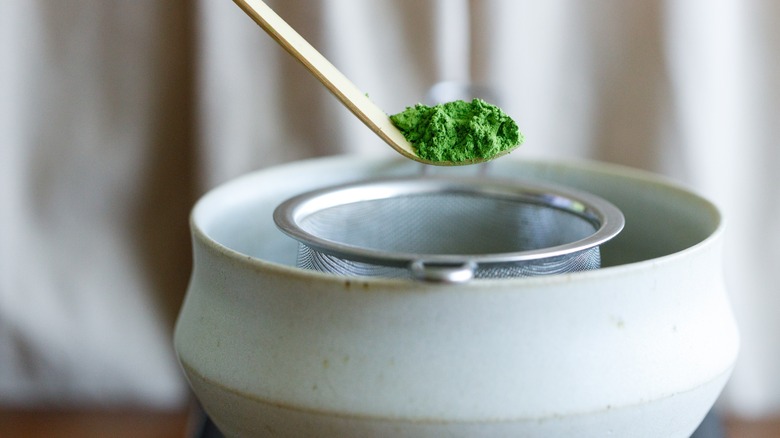Ceremonial Grade Matcha Doesn't Mean Anything – Here's How To Actually Pick The Best Tea
Used in Japan for centuries, matcha has enjoyed rising popularity around the world in the past decade. The powder is made with ground green tea leaves and is traditionally used in Japanese tea ceremonies. In the West, it's often added into hot, milky drinks or added as a flavoring component to foods. High-quality matcha is usually handpicked and has a delicate flavor. However, rising demand and unfortunate supply issues have led to consumers paying more for their matcha, causing the Western market to become flooded with subpar products.
To discern the quality of a product, customers can check the label. Joey Wight, co-founder of Wight Tea Co. explains that, "In the Western world, culinary and ceremonial grades of matcha are supposed to be used to denote quality. Culinary is a lower quality while ceremonial is meant for beverages." That sounds simple enough, right? Not so fast. "'Ceremonial Matcha' is considered to be a subjective term because the term is not regulated," he said. "Any business can call any matcha ceremonial and mark up the price."
That's not to say that the term is always misleading. In fact, Wight still thinks the label is a good place to start for consumers who want a high-quality product, especially when selection is limited. "While your best bet in a grocery store or online setting would probably be to go for matcha labeled as ceremonial, you may also want to look for options like 'cafe-grade.'" Still, that lack of regulation basically makes false advertising fair game. Checking the label is only the first step.
Other things to look for when buying matcha
Once you've checked the label and found a product that claims to be ceremonial or cafe grade matcha, there are other factors you can look for. "Matcha should always be sourced from Japan, and you can narrow your aim to Nishio, Aichi, or Kyoto, which are the top producers of tencha — shade-grown leaves." Knowing what regions have a good reputation is a great way to see if the brand knows what they're doing.
"You also want to check to make sure your matcha has no fillers. Plenty of matcha sellers bulk up their matcha with things like powdered milks, sugars, etc. It feels like you are getting more bang for your buck, but you're really paying for all the extra stuff and you lose control over your beverage," Wight claims. Even Starbucks is guilty of doing this, so the practice is fairly prevalent.
You can also do a visual and taste test to inspect whether the product is high-quality. "You'll want a vibrant green matcha that doesn't look clumpy," says Wight. Clumpy matcha can happen if you don't store it in an air-tight container, but other factors can cause it. "If your matcha is clumpy or chalky it was possibly either exposed to air, is old, or just isn't very high quality." Wight had some thoughts on flavor, as well. "For flavor, you want green, grassy, creamy, and fresh." Once you've found a product that meets all these criteria, you can rest assured that you're getting the real deal.

